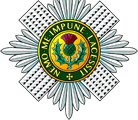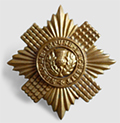The origins of the Scots Guards date from 1642 when King Charles I directed Archibald Campbell, Marquis of Argyll, to command and send a regiment of 1500 men to Ireland to deal with a rebellion, while their royal connections as personal troops of the Sovereign and their designation as Foot Guards date from 1650 after the exiled King Charles II landed in Scotland. The years from 1642 were ones of turbulent civil war and religious discord throughout the British Isles and when in 1651 Charles attempted to regain the English throne he was heavily defeated at the Battle of Worcester and his Army scattered. Not till after the Restoration in 1660 was he able to start to re-raise personal troops in Scotland. Only in 1662 did these become a Regiment of Foot Guards once more, with differing titles up to 1877 when permanently renamed the Scots Guards, used here for simplicity’s sake throughout.
For the next twenty five years the Scots Guards served in Scottish garrisons protecting the coast from enemy raids during the Dutch Wars and, as religious discord persisted, assisting in operations against the Covenanters, notably at the Battle of Bothwell Brig in 1679. After King James II came to the throne in 1685 the Scots Guards, reequipped with more modern muskets, though a quarter of the men were still armed with pikes, adopted a battlefield formation of three ranks for the first time, which, sometimes varied to two ranks, would feature for two hundred years afterwards and hence, famously, “the thin red line”. The King then ordered half of the Scots Guards to England in 1686 and these companies, styled a battalion, landed near London and were soon encamped on Hounslow Heath with two other Regiments of Foot Guards, now the Grenadier and Coldstream Guards. This was the first time that the name Scots Guards was used and when the other two Regiments gave them the nickname of “The Kiddies”. They also joined the English Army for the first time as junior to the Grenadiers and Coldstreamers, hence the Third Regiment of Foot Guards, and that is why they wear their buttons in threes. The King, unlike his much more accommodating elder brother Charles, was an unbending Catholic, who tried to remove as many Protestant officers as he could from the Army. By 1688 there was considerable ill feeling about him. It affected the Scots Guards and when William of Orange arrived it was not long before they swore allegiance to him, several Catholic officers excepted.
The reign of King William III and Queen Mary (a Protestant daughter of King James) changed the diplomatic and military dynamics of the British Isles in a way which continued to 1945. From long before this the Dutch had been struggling against Spanish and later French domination. So since William also ruled Holland he was only too glad when opportunity offered in 1689 to send troops out from England to fight on the Continent. The War of the League of Augsburg, a coalition against King Louis XIV of France, lasted until 1697. The fighting, mainly siege warfare, was not in Holland, but mostly was in Flanders (modern Belgium and north eastern France), where the Scots Guards would fight again and again in the years to come. In 1695 they won their earliest Battle Honour “NAMUR” when British and Dutch troops led by William himself captured the fortress and town. Two years later the Scots Guards went back to Scotland, their role protection against the Jacobite threat, and so had no direct involvement in the war of the Spanish Succession 1701 to 1714, again with France as the principal enemy, until they went to Spain in 1709 in an ill starred expedition largely over ground they would see again a hundred years later in the Peninsular War. At this time there were still companies of the Scots Guards in Scotland but all of them went to London in 1712.
From 1720 to 1742 the three Regiments of Foot Guards were in London, engaged, in the absence of a police force, in carrying out all manner of public order duties. These included accompanying the condemned to the gallows, preventing disturbances when lesser offenders were put in the pillory and even catching poachers on royal property. One particularly colourful role was the supervision of balls at the King’s Theatre, Haymarket, where the duty of bringing the evening’s entertainment to an end lay with the Sergeant Major who was required “to oblige the musicians and butlers to retire in good time”. Then came the War of the Austrian Succession from 1742 to 1748. While Britain’s allies in the series of wars in this century varied, France was constantly the main enemy. By this time too, there was another dimension in that King George II was also Elector of Hanover, with a very keen interest in North German affairs. A British force including the Scots Guards landed at Ostend in 1742 and they gained the Battle Honour “DETTINGEN” in a victory to the east of Frankfurt, the last time a British King led on the field of battle. The other main battle of the War, in 1745, at Fontenoy in Belgium, has gone down to history as a French victory because they were left in possession of the battlefield. The Foot Guards gained great credit, but no battle honour.
Meanwhile there was Bonnie Prince Charlie and the 1745 Jacobite Rebellion, initially a cause of great disturbance and apprehension. The Scots Guards battalion still in England was in the force that the Duke of Cumberland placed in Staffordshire, to threaten Bonnie Prince Charlie’s communications and flank had he tried to head further south from Derby. The Scots Guards had no direct contact with the Jacobite Army but one former officer who served from 1710 to 1712 most certainly did. Lieutenant General Sir John Cope, whose army was routed at dawn at Prestonpans, became the butt of the famous song “Hey, Johnnie Cope, Are Ye Waking Yet?” habitually played nowadays by Scots Guards pipers at Reveille. One interesting custom which persists to this day stemmed from an order issued by the Duke of Cumberland in Scotland that in all Regiments their Union Colour was to take precedence over the King’s Colour except in the Foot Guards where the King’s Colour would be “the first as a particular distinction”.
Next came the Seven Years War from 1756 to 1763, the Scots Guards being limited to participating in the expedition which successfully destroyed the defences of Cherbourg and its shipping in 1758, followed by some inconclusive, but far from light battles in central Germany in 1761 and 1762, again without battle honours. Back home the Foot Guards were in their policing role, which in 1768 and later meant the suppression of the riots caused by the arrest of John Wilkes, a radical MP. In the American War of Independence a composite battalion drawn from all three Regiments was present at the British victory of Guildford Court House and ultimately at the surrender at Yorktown. At home however there was rioting with a different theme. Lord George Gordon stirred up the London mob because of measures introduced in Parliament to ease the restrictions on Roman Catholics. A very great deal of damage was done and it was extremely difficult for the Foot Guards and other troops brought in to restore order in the absence of the political will to do so. In the Wilkes Riots the Scots Guards were unpopular with the mob because they were Scots, but in the Gordon Riots popular because they were Protestants.


